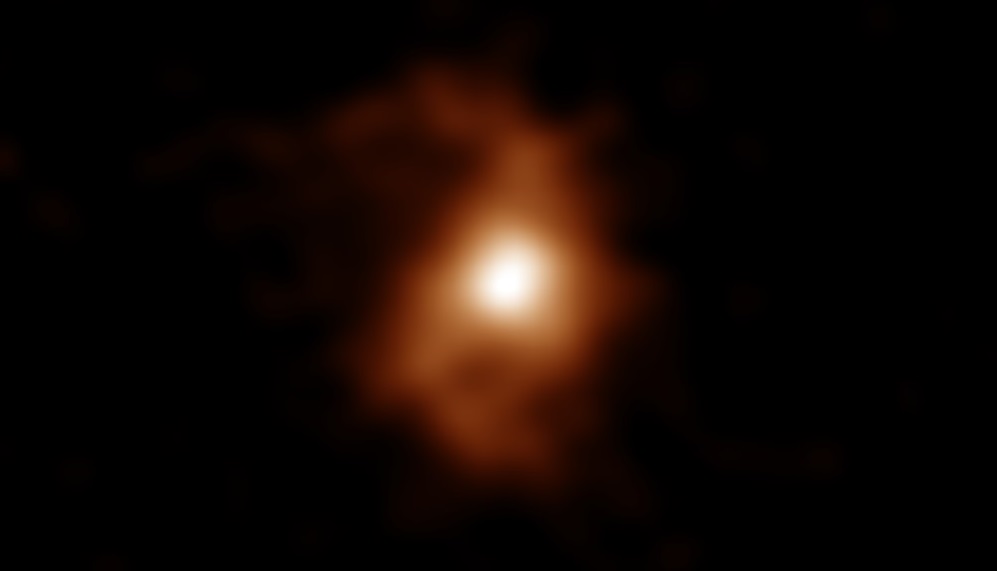
Using the telescope known as the Atacama Large Millimeter/submillimeter Array (ALMA), a team of researchers may have found the most distant spiral galaxy ever seen, according to a statement.
The galaxy, dubbed BRI 1335–0417, is estimated to have formed only 1.4 billion years after the Big Bang, making it the most ancient known galaxy with a spiral morphology. The discovery of this galaxy in the very early universe sheds light on the formation and evolution of spiral galaxies in cosmic history.
“I was excited because I had never seen such clear evidence of a rotating disk, spiral structure, and centralized mass structure in a distant galaxy in any previous literature,” said Takafumi Tsukui, a graduate student at the university SOKENDAI and the lead author of the research paper, in the statement. “The quality of the ALMA data was so good that I was able to see so much detail that I thought it was a nearby galaxy.”
Spiral galaxies are frequently seen in the universe. As many as 70 percent of all galaxies are the spiral variety. These galaxies are named for the spiral arm structures that extend from the center into the galactic disk.
Some studies have shown that the proportion of spiral galaxies declines rapidly at larger distances in the universe, indicating that spiral galaxies may form relatively late in cosmic history.
Tsukui and his supervisor Satoru Iguchi, a professor at SOKENDAI and the National Astronomical Observatory of Japan, noticed BRI 1335-0417 in the ALMA Science Archive.
The galaxy is about 12.4 billion years old, the statement reported. It contains a large amount of dust, which makes it difficult to study with visible light. But radio emissions from carbon ions are not blocked, so ALMA can provide a view of the galaxy.
The research team detected a spiral arm structure extending about 15,000 light-years from the galactic center. This is about one third of the size of our Milky Way. The research team estimated that the total mass of BRI 1335-0417 is comparable to that of the Milky Way.
“As BRI 1335-0417 is a very distant object, we might not be able to see the true edge of the galaxy in this observation,” Tsukui added. “For a galaxy that existed in the early Universe, BRI 1335-0417 was a giant.”
However, spiral galaxies are mature galaxies. Usually in the early universe, galaxies were still forming, so they should not show these mature structures. It’s unclear why this spiral galaxy was able to grow mature in only 1.4 billion years.
This is a question that challenges ideas about overall galactic evolution in the universe. The research team considered several possible scenarios. In the end, they suggested that it could be due to interactions with a small galaxy.
According to the statement, BRI 1335-0417 is forming stars actively. This can happen when a galaxy collides with a smaller galaxy that can supply a large amount of gas from outside.
As with most cosmic objects, there are more unknowns than knowns. The fate of BRI 1335-0417 is unpredictable, the statement reported.
It might change from a disk galaxy to an elliptical one in the future, since many similar ancient galaxies are considered to be ancestors of present-day elliptical galaxies. Or it may be a spiral galaxy for a long time.
“Our Solar System is located in one of the spiral arms of the Milky Way,” Iguchi said in the statement. “Tracing the roots of spiral structure will provide us with clues to the environment in which the Solar System was born. I hope that this research will further advance our understanding of the formation history of galaxies.”
The new discovery is described in a paper published in the journal Science.
A supercomputer simulation of spiral galaxy formation. Over a period of about 13.5 billion years, small galaxies merge one after another into a single giant spiral galaxy. Please note that this video was created in 2007 and is not a reproduction of the current study. Video credit: Takaaki Takeda, Sorahiko Nukatani, Takayuki Saito, 4D2U Project, NAOJ
 RSS Feed
RSS Feed















 May 30th, 2021
May 30th, 2021  Awake Goy
Awake Goy  Posted in
Posted in  Tags:
Tags: 













